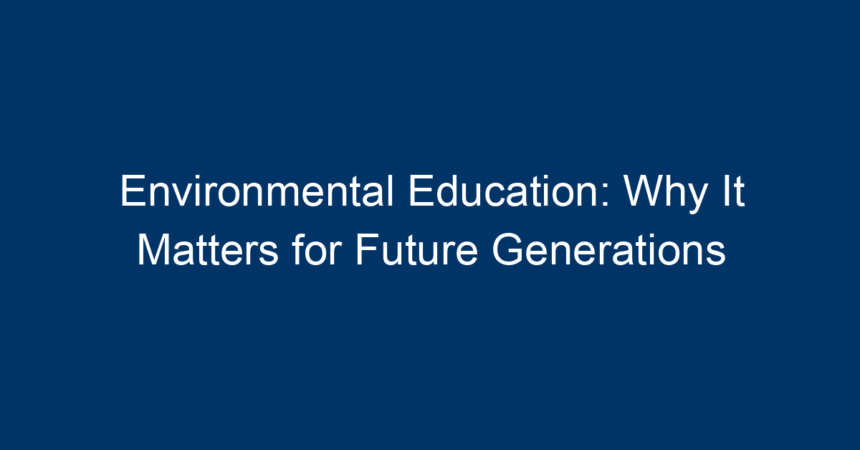In today’s rapidly changing world, the importance of environmental education cannot be overstated. As we face escalating challenges such as climate change, biodiversity loss, and pollution, equipping future generations with the knowledge and skills to navigate these issues is paramount. This article delves into the significance of environmental education, its role in developing responsible citizens, and actionable insights for fostering a culture of sustainability.
Understanding Environmental Education
What is Environmental Education?
Environmental education refers to a broad range of activities and programs aimed at imparting knowledge about the environment and promoting awareness of ecological issues. It encompasses various disciplines, including science, geography, and social studies, and seeks to foster a critical understanding of the natural world. Essentially, it prepares learners to think critically about their environment and to engage in sustainable practices.
The Objectives of Environmental Education
The primary objectives of environmental education include:
- Awareness: Creating an understanding of environmental issues and their implications.
- Knowledge: Imparting essential facts about ecosystems, climate change, and biodiversity.
- Attitudes: Encouraging values and attitudes that promote environmental stewardship.
- Skills: Equipping individuals with skills to solve environmental problems.
The Importance of Environmental Education for Future Generations
1. Fostering Environmental Awareness
A cornerstone of environmental education is its ability to raise awareness about pressing global issues. Young people who are educated about environmental problems are more likely to appreciate the interconnectedness of ecosystems and human activities. This awareness is crucial in shaping informed citizens who can advocate for the planet.
2. Building Sustainable Practices
Environmental education teaches sustainable practices that individuals can implement in their daily lives. From recycling to conservation, students learn how their actions can positively impact the environment. By instilling these practices early, we can cultivate a generation that values sustainability and integrates eco-friendly habits into their lifestyles.
3. Empowering Future Leaders
Leaders of tomorrow will face challenges that require innovative solutions. Environmental education empowers students to think critically and creatively about ecological issues. It promotes problem-solving and critical thinking skills that are essential in addressing environmental crises, thereby fostering a new generation of responsible leaders.
4. Promoting Community Involvement
A well-educated population is more likely to participate in community initiatives aimed at environmental preservation. Programs that engage students in local conservation projects can make a tangible difference. By involving youth in hands-on activities, they learn the value of teamwork and collective action in safeguarding their communities.
5. Encouraging Lifelong Learning
Environmental education instills a sense of curiosity about the natural world. Students who are engaged in this kind of learning often develop a lifelong interest in nature and environmental issues. This curiosity can lead to further educational pursuits in environmental science, policy, or advocacy, contributing to a more informed society.
Integrating Environmental Education into Curricula
1. Collaborative Learning
Incorporating collaborative projects can enhance learning experiences. Schools can partner with environmental organizations to provide real-world experiences, such as field trips, workshops, and cleanup events. These partnerships create a bridge between theoretical knowledge and practical application.
2. STEM Integration
Integrating science, technology, engineering, and mathematics (STEM) with environmental education can provide a robust framework for understanding ecological issues. Students can engage in projects that involve data collection, analysis, and problem-solving, giving them tools to tackle real-world challenges.
3. Outdoor Classrooms
Utilizing outdoor spaces as classrooms can vastly enhance students’ learning experiences. Outdoor education not only engages students but also fosters a direct connection between them and the environment. Activities like nature walks, ecosystem studies, and biodiversity surveys encourage experiential learning.
4. Interdisciplinary Approach
Environmental issues are complex and require a multidisciplinary approach. Incorporating literature, art, and social sciences into environmental education can help students understand the cultural and ethical implications of environmental issues, promoting a well-rounded perspective.
Global Initiatives Promoting Environmental Education
1. UNESCO’s Education for Sustainable Development
UNESCO has been a key player in promoting environmental education worldwide through its Education for Sustainable Development (ESD) program. This initiative aims to integrate sustainability principles into education systems globally, ensuring that future generations are prepared to face environmental challenges.
2. The Earth Day Network
The Earth Day Network promotes environmental education through programs that engage students and communities in environmental activism and stewardship. Initiatives such as Earth Day activities foster a sense of responsibility and community among participants.
3. Local and National Curricular Standards
Many countries are now incorporating environmental education into their national curricula. For example, the Next Generation Science Standards in the U.S. emphasize the importance of environmental literacy and encourage schools to adopt eco-friendly practices.
Actionable Insights for Promoting Environmental Education
1. Advocate for Schools to Adopt Environmental Curricula
Parents, educators, and community leaders can advocate for the inclusion of environmental education in school curricula. Attend school board meetings to voice the importance of eco-conscious learning and suggest programs that have proven successful elsewhere.
2. Support Local Environmental Initiatives
Community involvement can amplify the impact of environmental education. Support local organizations that focus on conservation, sustainability, and environmental awareness. Volunteer your time, or offer to organize events that engage youth.
3. Encourage Outdoor Experiences
Parents can facilitate outdoor experiences for their children. Activities like hiking, camping, or visiting nature reserves can nurture a love and appreciation for the environment. This instills a sense of responsibility that lasts a lifetime.
4. Leverage Technology
Utilize educational technology tools, apps, and online resources to enhance environmental learning. Interactive platforms can make learning fun and engaging, fostering a deeper understanding of environmental issues.
5. Promote Sustainable Practices at Home
Model sustainable practices at home, such as reducing waste, recycling, and conserving energy. Engage children in discussions about environmental choices, which reinforces lessons learned in school.
Conclusion: The Path Forward
Environmental education plays a crucial role in shaping informed and responsible citizens. By fostering awareness, building sustainable practices, and empowering future leaders, we can pave the way for a healthier planet. As we move forward, it’s important to advocate for the integration of environmental education across curricula, support local initiatives, and encourage active participation in environmental stewardship. Every small effort counts in creating a sustainable future for generations to come.
As communities come together to prioritize environmental education, we can cultivate a culture of responsibility and sustainability, ultimately safeguarding our planet for the future. Allow the seeds of knowledge to bloom, and together, we can achieve a world where ecological awareness resonates across generations.




